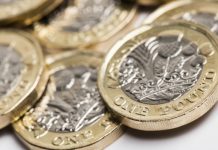The pound rallied hard versus the dollar on Friday, regaining some ground lost earlier in the week. The pound US dollar exchange rate initially slipped to US$1.2786 before climbing and closing the week out at US$1.2896. The pound was moving higher versus the dollar at the start of the new week.
| What do these figures mean? |
|---|
| When measuring the value of a pair of currencies, one set equals 1 unit and the other shows the current equivalent. As the market moves, the amount will vary from minute to minute.For example, it could be written:1 GBP = 1.28934 USDHere, £1 is equivalent to approximately $1.29. This specifically measures the pound’s worth against the dollar. If the US dollar amount increases in this pairing, it’s positive for the pound. Or, if you were looking at it the other way around:1 USD = 0.77786 GBPIn this example, $1 is equivalent to approximately £0.78. This measures the US dollar’s worth versus the British pound. If the sterling number gets larger, it’s good news for the dollar. |
The pound picked up in the second half of last week following impressive UK retail sales data. Data showing that UK retail sales jumped 1% in January month on month helped lift the pound. Investors cheered the fact that UK consumers are still spending despite Brexit anxiety. This is good news for the UK economy which is so dependent on consumers spending.
The pound could be volatile this week as Brexit remains as key driving force for sterling. UK Prime Minister Theresa May experienced another embarrassing defeat in the House of Commons last week, which increased the possibility of a no deal Brexit and unnerved investors. Despite losing the support of Parliament, Theresa May is heading back to Brussels for a last-ditch attempt to get the EU to agree to changes to the Irish backstop arrangement of her Brexit deal. Theresa May’s success in Brussels could depend on her ability to present a united front at home. Signs of a deal being achieved could lift the pound.
| Why is a “soft” Brexit better for sterling than a “hard” Brexit? |
|---|
| A soft Brexit implies anything less than UK’s complete withdrawal from the EU. For example, it could mean the UK retains some form of membership to the European Union single market in exchange for some free movement of people, i.e. immigration. This is considered more positive than a “hard” Brexit, which is a full severance from the EU. The reason “soft” is considered more pound-friendly is because the economic impact would be lower. If there is less negative impact on the economy, foreign investors will continue to invest in the UK. As investment requires local currency, this increased demand for the pound then boosts its value. |
Theresa May now has two weeks to save her Brexit deal before a vote in Parliament on 27th February, which could see the Brexit process taken out of Theresa May’s hands.
Trade Talks & Fed To Drive Dollar
The dollar lost ground towards the end of last week as progress was reported in the US—Sino trade talks. As trade tensions eased, investors moved out of the dollar which is considered a safe haven. As the world’s reserve currency, in times of geopolitical tensions investors buy into the dollar. The reverse is true in times of improving relations. Talks will continue in Washington this week as both sides scramble to achieve an agreement before the March 1 trade truce deadline.
Today could be a quiet day for the dollar, given the US public holiday, President’s day. However, the Fed minutes from the January meeting due to be released on Wednesday could inject some volatility into the dollar. Further signs that the Fed will hold off from raising interest rates this year could weigh on demand for the greenback.
| Why do raised interest rates boost a currency’s value? |
|---|
| Interest rates are key to understanding exchange rate movements. Those who have large sums of money to invest want the highest return on their investments. Higher interest rate environments tend to offer higher yields. So, if the interest rate or at least the interest rate expectation of a country is relatively higher compared to another, then it attracts more foreign capital investment. Large corporations and investors need local currency to invest. More local currency used then boosts the demand of that currency, pushing the value higher. |
This publication is provided for general information purposes only and is not intended to cover every aspect of the topics with which it deals. It is not intended to amount to advice on which you should rely. You must obtain professional or specialist advice before taking, or refraining from, any action on the basis of the content in this publication. The information in this publication does not constitute legal, tax or other professional advice from TransferWise Inc., Currency Live or its affiliates. Prior results do not guarantee a similar outcome. We make no representations, warranties or guarantees, whether express or implied, that the content in the publication is accurate, complete or up to date. Consult our risk warning page for more details.
This article was initially published on TransferWise.com from the same author. The content at Currency Live is the sole opinion of the authors and in no way reflects the views of TransferWise Inc.




